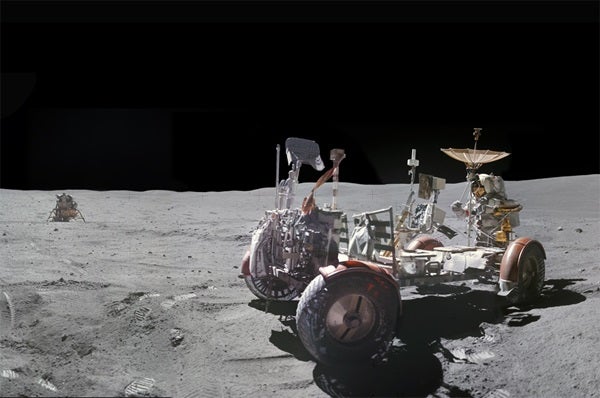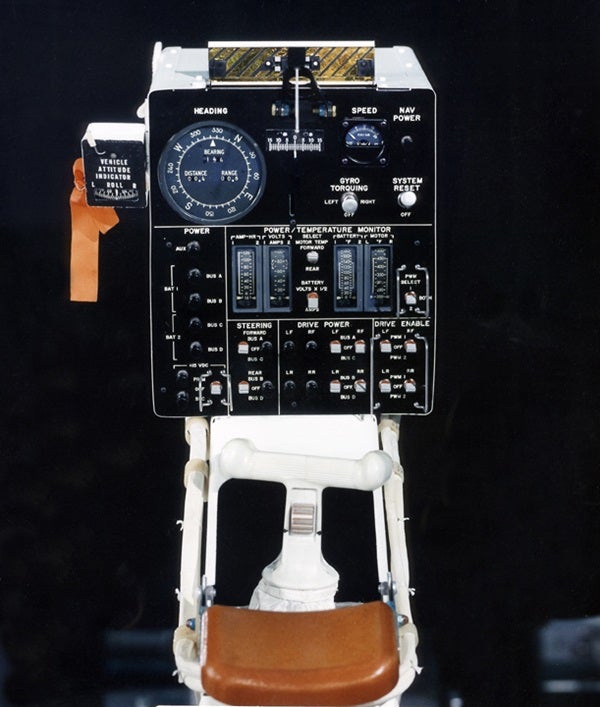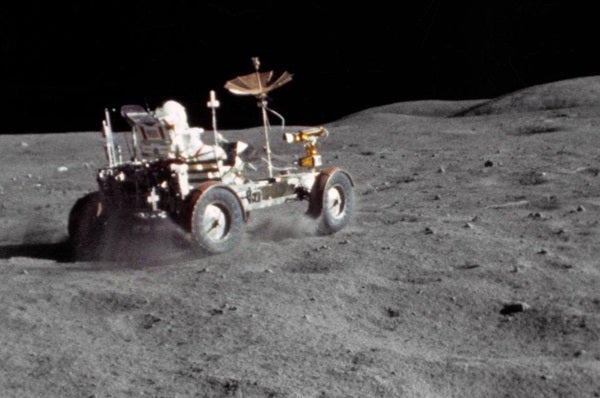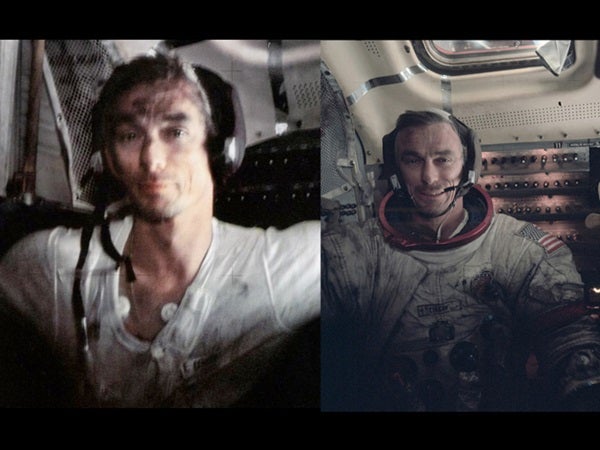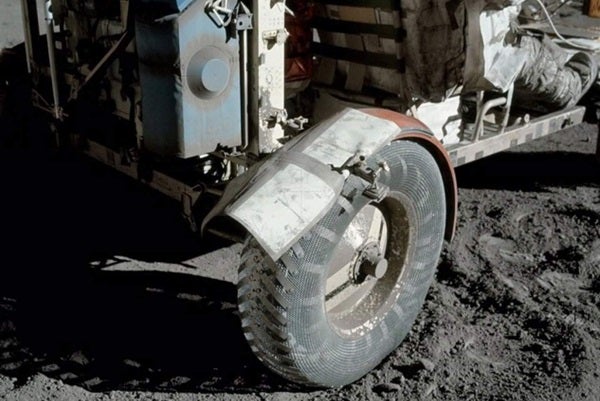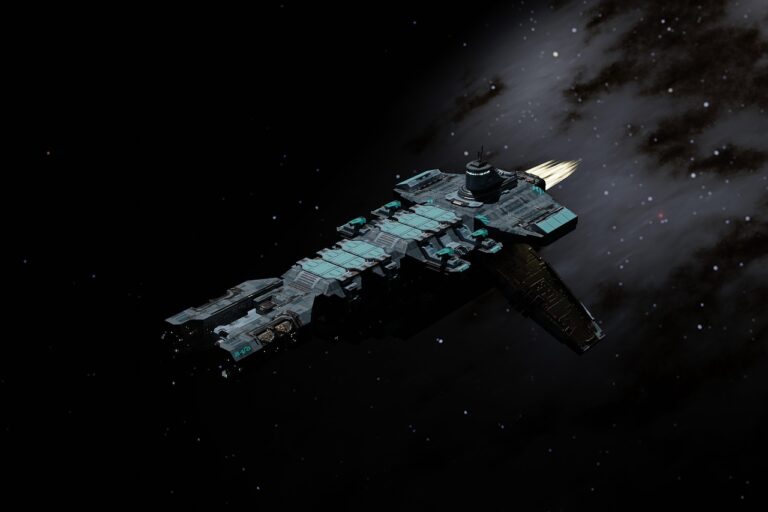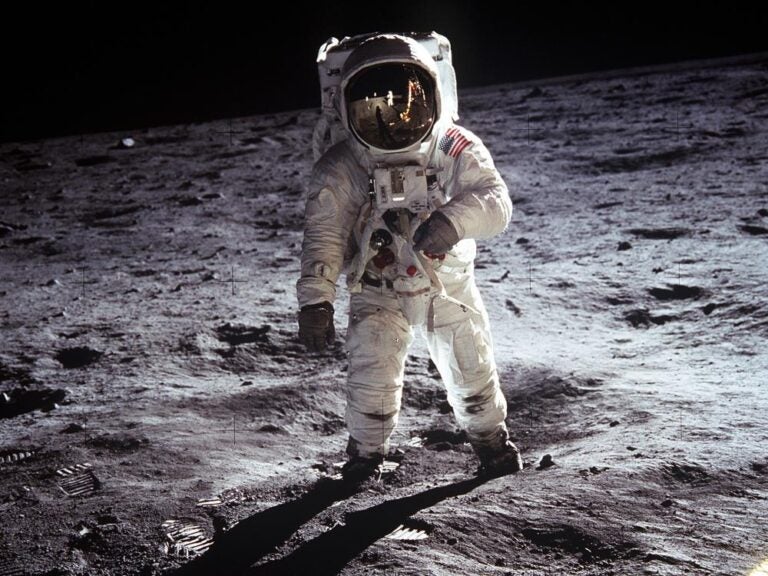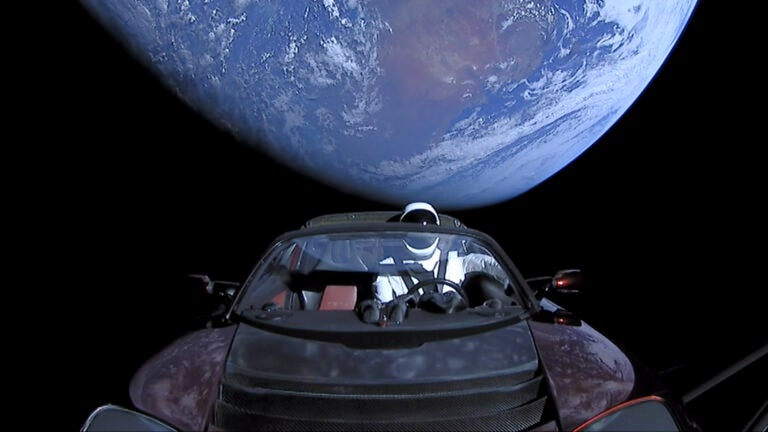A decade before President Kennedy’s 1961 call to land men on the Moon, two men outlined their vision for what lunar surface exploration might realistically look like. Their fictional moonwalkers rode on “surface vehicles, tank-like cars with caterpillar treads for mobility over the Moon’s rough surface.” These “Moon cars” ran on a combination of hydrogen peroxide and fuel oil, and could travel 25 mph (40 kph) on flat terrain to cover a maximum range of about 250 miles (400 kilometers).
These visionaries were Fred Whipple, chairman of the department of astronomy at Harvard University, and Wernher von Braun, technical director of the Army Ordnance Guided Missiles Development Group and often considered the father of modern rocketry. Together, they presented novel ideas on how we’d land on and explore the Moon in a 1952 Collier’s Weekly article, “The Exploration.” Their vision included using vehicles to transport men and materials farther and more efficiently.
Whipple and von Braun had imagined a huge, weeks-long lunar exploration party with multiple ships carrying tens of men; Apollo, by contrast, carried just two men to the lunar surface (while a third orbited overhead). But the idea of a Moon car was still an appealing one, and the Lunar Roving Vehicle, or LRV, used on later, longer Apollo missions maximized scientific pursuits by expanding the area the men could cover.
Boeing and General Motors’ Delco electronics division were contracted to build the LRVs for NASA. The vehicles needed to minimize weight and maximize efficiency during relatively short lunar stays ranging from about 22 to 75 hours. Work began in 1969 and the first vehicle was delivered in March 1971. Though the original contract was for $19 million, costs inevitably ballooned and the three LRVs — one each was carried on Apollo 15, 16, and 17 — ultimately cost NASA $38 million.
In total, the LRV was about 10 feet (3 meters) long and 6 feet (1.8 m) wide. Empty, it weighed 460 pounds (210 kilograms), and could carry an additional 1,080 lbs (490 kg), which included two full-grown men, their 180-lb (82 kg) spacesuits, as well as any tools and rocks they might excavate to bring back to the LM.
The vehicle was powered by two 36-volt silver-zinc potassium hydroxide batteries, which drove four 0.25-horsepower motors (one for each of the rover’s wheels). The LRV could move both forward and backward with a speed limit of about 9 mph (14 kph) — not quite as speedy or as heavy as Whipple and von Braun’s imagined Moon cars, but impressive nonetheless. It could navigate across crevasses about 2 feet (0.6 m) wide and over obstacles, such as rocks, up to 1 foot (0.3 m) high.
Rather than a steering wheel, a T-shaped controller between the two astronauts’ seats controlled the wheels, drive motors, and brakes. Pressing forward moved the rover straight forward (or in reverse, if set in the correct mode), while rotating the joysticklike control left or right pointed the wheels for a turn. Astronauts typically oriented the vehicle during trips using a directional gyro (a device that uses a gyroscope to provide headings in aircraft) and odometer, though they could also use the rover’s manual Sun-shadow device if necessary. The LRV also carried its own antenna, tool caddies, and cameras.
Pack it up
But once you have a Moon car, how do you get it to the Moon?
The LRV was designed as a collapsible vehicle that folded up inside the descent stage of the Lunar Module (LM) with all four wheels on top and facing inward, while the flat bottom of the rover faced out. Once on the lunar surface, the LRV could be unpacked by two astronauts, even in bulky gear, by pulling on ropes and a D-handle to detach the vehicle from the LM. Most of the rover’s deployment was automatic, with torsion bars flipping the wheels into the correct positions as the rover was lowered to the ground. Once on its wheels, the two open-air seats were flipped up, the footrests fixed into place, and the rover was ready for roving. During Apollo 15, the entire process took astronauts James Irwin and David Scott about 40 minutes from start to finish.
Like every piece of equipment taken to the Moon, the LRV had to function over a wide range of temperatures, from about –200 to 250 degrees Fahrenheit (–128 to 121 degrees Celsius). To avoid overheating, the rover’s electronics were kept cool via several methods, including specialized paints and coatings, wax boxes that pulled heat from electronics, and radiator panels that could be exposed by opening a cover to allow heat to escape between excursions. And while the rover could be parked in the shadow of the LM to cool down after a drive, it could not be left there for more than two hours or the astronauts risked the opposite: cold damage to the vehicle’s electronics.
But one of the rover’s most important heat-beating tools was its fenders. Not just included for a more carlike appearance, these components were essential to the rover’s function because they kept the rover’s wheels, made of wire mesh with titanium chevrons for added traction, from kicking up excessive dust during drives.
Although clinging dust was a problem in and of itself, darker-colored dust would absorb heat from the Sun, warming the surfaces it was on and in to potentially damaging high temperatures. For example, dust that settled onto the rover’s radiator panels reduced their efficiency, further limiting the rover’s ability to cool down. Astronauts spent significant time cleaning dust off the rover, brushing dust off panels to improve their ability to radiate heat away — at least, until the next trip coated them again.
Videos of the LRV in action offer a unique look at conditions on the Moon. As the rover moves, it kicks up dust behind the vehicle in a “rooster tail” (as the astronauts called it), thanks to the Moon’s lower gravity. That’s because on the Moon, that gravitational pull is just 1/6 of that you would feel on Earth. Combined with its airless environment, anything launched off the surface — be it golf balls or dust — goes flying much farther than it would on Earth before settling back down. So basically, no matter what you’re doing on the Moon, dust gets everywhere. It even gave astronaut Harrison Schmitt temporary hay fever-like symptoms, including a sore throat.
‘There goes a fender’
But the dust-busting fenders only worked, of course, while they remained intact and attached to the rover. During the first EVA of Apollo 17, a hammer in astronaut Gene Cernan’s strap-on shin pocket caught on the rover’s right rear fender, pulling it off the vehicle.
“Oh – there goes a fender,” Cernan can be heard saying, chagrined, on recordings of the mission. “Oh, shoot,” Schmitt agreed, seconds later.
Fortunately, another vital component of Apollo was duct tape (innocuously labeled as simply “tape”). While Schmitt forged on ahead, Cernan taped the dislodged fender back into place. It was no easy task: “Good old-fashioned American gray tape doesn’t stick to lunar-dust-covered fenders,” Cernan lamented; but eventually, he managed to reaffix the fender “for an indefinite period of time,” he predicted.
“I never thought I’d be out here doing this,” Cernan said of fixing a fender on the Moon, as he got back to work on the EVA’s main tasks once he’d finished. The two astronauts continued on in the rover to other sites; the duct-taped fender held for some time, but eventually it fell off in transit due to dust on the tape, which prevented it from holding the fender securely. While neither astronaut noticed the fender falling off, Schmitt did note an immediate increase in the amount of dust falling back on the astronauts and the rover as they drove, piping up with, “I think you have lost a fender. I keep getting rained on here [with lunar dust].”
Already on their way back to the LM, the pair carried on with only three fenders. By the time they reached to the LM, Cernan noted that the dust on the rover’s battery covers was thick enough to write in — much worse than the normal, thin layer of dust that would accumulate with a working fender. They needed a solution — and this time, it needed to include a new fender.
The solution worked — the dust problem was reduced to a manageable one and the astronauts went on to use the rover for an additional 15 hours of EVA activities. Before leaving the Moon, they removed the remaining three intact fenders, as well as the replacement, to return to Earth.
Leaving tracks
His experience on Apollo 17, to Schmitt, exemplified one of the most significant challenges of exploring our satellite over the long term. “The dust issue is one that just has to be addressed. It’s going to be the major environmental issue for future missions to the Moon,” he said following his return to Earth.
But among many other challenges presented to astronauts and engineers throughout the course of Apollo, teamwork and ingenuity ensured that not only could we take a car to the Moon, we could also repair it when things unexpectedly went wrong.
Ultimately, the LRV allowed astronauts to explore more of the Moon than they could have ever reached on foot, boosting the total distance traveled during EVAs from 3,300 feet (1 km) on Apollo 11 to 19.3 miles (31 km) by Apollo 17 and increasing the total samples collected from 47.5 lbs (21.5 kg) to 244 lbs (111 kg).
In total, NASA left three Lunar Roving Vehicles on the surface of the Moon. They are still parked near the descent stage of each mission’s LM, which also served as a launchpad when lifting off from the Moon. The cameras on the rovers were used to film the later liftoffs, capturing the spray of foil and dust as the ascent stage sped rapidly upward. The camera continued to film until the rover’s battery died and the last transmissions from the lunar surface went dark.

